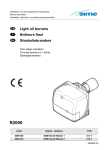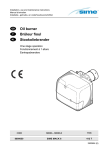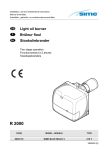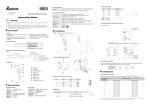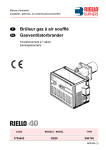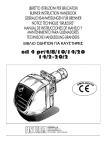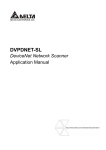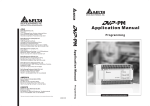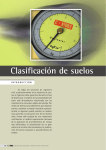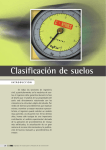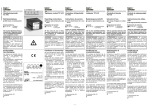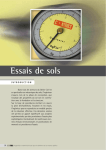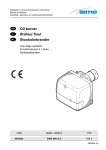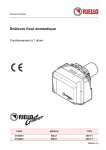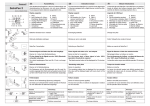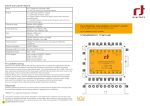Download Oil burners Brûleurs fioul Stookoliebranders - E
Transcript
Installation, use and maintenance instructions Manuel d’entretien Installatie-, gebruiks- en onderhoudsvoorschriften GB F NL Oil burners Brûleurs fioul Stookoliebranders One stage operation Fonctionnement à 1 allure Eentrapsbranders CODE MODEL - MODELE TYPE 8099000 SIME MACK 3 514 T1R 8099010 SIME MACK 4 515 T3R 8099030 SIME MACK 5 515 T5R 2902683 (0) 4 INDEX 1. BURNER DESCRIPTION . . . . . . . . . . . . . 1 4. WORKING . . . . . . . . . . . . . . . . . . . . . . . 6 1.1 Burner equipment . . . . . . . . . . . . . . . . . . 1 4.1 Combustion adjustment. . . . . . . . . . . . . . 6 4.2 Nozzles recommended . . . . . . . . . . . . . . 6 2. TECHNICAL DATA . . . . . . . . . . . . . . . . . 2 4.3 Electrodes setting . . . . . . . . . . . . . . . . . . 7 2.1 Technical data . . . . . . . . . . . . . . . . . . . . . 2 4.4 Air damper adjustment . . . . . . . . . . . . . . 7 2.2 Working fields . . . . . . . . . . . . . . . . . . . . . 2 4.5 Pump pressure . . . . . . . . . . . . . . . . . . . . 7 2.3 Overall dimensions . . . . . . . . . . . . . . . . . 3 4.6 Fuel heating . . . . . . . . . . . . . . . . . . . . . . 7 4.7 Burner start-up cycle. . . . . . . . . . . . . . . . 8 5. MAINTENANCE . . . . . . . . . . . . . . . . . . . 8 6. FAULTS / SOLUTIONS . . . . . . . . . . . . . . 9 3. INSTALLATION . . . . . . . . . . . . . . . . . . . . 3 3.1 Boiler fixing . . . . . . . . . . . . . . . . . . . . . . . 3 3.2 Hydraulic systems . . . . . . . . . . . . . . . . . . 4 3.3 Electrical wiring . . . . . . . . . . . . . . . . . . . . 5 1. BURNER DESCRIPTION One stage light oil burner. ■ ■ The burner meets protection level of IP 40, EN 60529. Burner with CE marking in conformity with EEC directives: EMC 89/336/EEC, Low Voltage 73/23/EEC, Machines 98/37/EEC and Efficiency 92/42/EEC. Fig. 1 3 2 4 7 5 6 5 1 D6272 1 – Oil pump 5 – Screws fixing air-damper 2 – Control-box 6 – Flange with insulating gasket 3 – Reset button with lock-out lamp 7 – Grommet 4 – Hydraulic jack with air-damper 1.1 BURNER EQUIPMENT Flange with insulating gasket . . . .No. 1 Screws and nuts for flange to be fixed to boiler . . No. 4 Screw and nuts for flange . . . . . .No. 1 Flexible oil pipes with nipples . . . . . . . . . . . . . . . . No. 2 Grommet . . . . . . . . . . . . . . . . . . .No. 1 7 pin plug . . . . . . . . . . . . . . . . . . . . . . . . . . . . . . . No. 1 2683 1 GB 2. TECHNICAL DATA 2.1 TECHNICAL DATA Model MACK 3 MACK 4 MACK 5 Output kg/h 1.4 – 2.2 2.0 – 3.2 2.8 – 3.9 Thermal power kW 16.6 – 26 23.8 – 37.9 33.3 – 46.2 (Hi = 11.86 kWh/kg) Light oil, max. viscosity at 20°C: 6 mm2/s Fuel Electrical supply Single phase, Motor Run current 0.7 A ~ 50Hz – 230 V ± 10% 2850 rpm – 298 rad/s 4 µF Capacitor Ignition transformer Secondary 8 kV Pump – 16 mA Pressure: 7 – 15 bar Absorbed electrical power 0.165 kW 0.185 kW 2.2 WORKING FIELDS (as EN 267) Pressure in the combustion chamber – mbar 0.8 0.6 0.4 MACK 3 0.2 0 1.2 1.4 1.6 1.8 2 2.2 2.4 Light oil output – kg/h D6282 16 18 20 22 24 26 Thermal power – kW 28 Pressure in the combustion chamber – mbar 1.2 1.0 0.8 0.6 0.4 MACK 4 MACK 5 0.2 0 2 2.2 2.4 2.6 2.8 31 33 3 3.2 3.4 3.6 3.8 4 Light oil output – kg/h D6283 23 25 27 29 35 37 39 2683 2 GB 41 43 45 47 Thermal power – kW 2.3 OVERALL DIMENSIONS Flange Burner 180 A = C 45° 72 F B 72 11 45 ° øE 91 D = 130 D6262 G 150 D5908 A B C D øE F G MACK 3 268 229 208 86 89 170 10 MACK 4 - MACK 5 285 249 230 86 89 186 16 Model 3. INSTALLATION 3.1 BOILER FIXING ➤ Put on the flange (1) the screw and two nuts, (see fig. 2). ➤ Widen, if necessary, the insulating gasket holes (5). ➤ Fix the flange (1) to the boiler door (4) using screws (2) and (if necessary) the nuts (3) interposing the insulating gasket (5), (see fig. 3). 4 5 Fig. 2 3 Fig. 3 2 E9131 1 1 2 E9132 2683 3 GB 3.2 HYDRAULIC SYSTEMS The burner is designed to allow entry of the flexible oil-lines on either side of the burner. WARNING: Fig. 4 7 ■ It is necessary to install a filter on the fuel supply line. The standard filter code 6276200 and that one with recirculation code 6276201 are available on request. 6 ■ The pump is designed to allow working with two pipes. 5 In order to obtain one pipe working it is necessary to unscrew the return plug (2), remove the by-pass screw (3) and then screw again the plug (2), (see fig. 4). ■ Before starting the burner make sure that the return pipe-line is not clogged. An excessive back pressure would cause the damage of the pump seal. L meters H meters I. D. 8 mm I. D. 10 mm 10 20 40 60 20 40 80 100 0.5 1 1.5 2 H max. 4 m SYSTEM NOT PERMITTED IN GERMANY Fig. 5 D6284 4 3 8 1 2 3 4 5 6 7 8 Suction line Return line By-pass screw Gauge connection Pressure adjuster Suction gauge connection Oil valve Auxiliary pressure test point H meters 0 0.5 1 1.5 2 3 3.5 max. 4 m H max. 4 m - Fig. 6 L meters I. D. I. D. 8 mm 10 mm 100 100 100 90 70 30 20 35 30 25 20 15 8 6 Fig. 7 H H 2 D5912 PRIMING PUMP: On the system in fig. 5 it is sufficient to loosen the suction gauge connection (6, fig. 4) and wait until oil flows out. On the systems in fig. 6 and 7 start the burner and wait for the priming. Should lock-out occur prior to the arrival of the fuel, await at least 20 seconds before repeating the operation. The pump suction should not exceed a maximum of 0.4 bar (30 cm Hg). Beyond this limit gas is released from the oil. Oil pipes must be completely tight. In the vacuum systems (fig. 7) the return line should terminate within the oil tank at the same level as the suction line. In this case a non-return valve is not required. Should however the return line arrive over the fuel level, a non-return valve is required. This solution however is less safe than previous one, due to the possibility of leakage of the valve. H 1 D6285 H = difference of level; L = max. length of the suction line; 2683 4 GB I. D. = internal diameter of the oil pipes. 3.3 ELECTRICAL WIRING NOTES: – Wires of 1 mm2 section. – The electrical wiring carried out by the installer must be in compliance with the rules in force in the Country. WARNING DO NOT EXCHANGE NEUTRAL WITH PHASE ~ 50Hz 230V PE N L TESTING Check the shut-down of the burner by opening the thermostats. Main switch T6A Hour counter (230V - 0.1A max.) Regulating thermostat Limit thermostat with manual resetting Remote lock-out lamp (230V - 0.5A max.) CONTROL BOX To remove the control-box from the burner, loosen screw (A, fig. 8) and pull to the arrow direction, after removing all components, the 7 pin plug and earth wire. Fig. 8 7 pin plug Start thermostat Heater 555SE CONTROL BOX CARRIED-OUT IN THE FACTORY 7 pole socket Black White Motor Capacitor Blue E9040 Oil valve A Burner-earth Ignition electrodes Fig. 9 Photoresistance D1847 ACCESS TO THE PHOTORESISTANCE (See fig. 9) Ignition trasformer The photoresistance is fitted directly into the control-box (underneath the ignition-transformer) on a plug-in support. E9102 Photoresistance 2683 5 GB 4. WORKING 4.1 COMBUSTION ADJUSTMENT In conformity with Efficiency Directive 92/42/EEC the application of the burner on the boiler, adjustment and testing must be carried out observing the instruction manual of the boiler, including verification of the CO and CO2 concentration in the flue gases, their temperatures and the average temperature of the water in the boiler. To suit the required appliance output, fit the proper nozzle, then adjust the pump pressure and the air damper opening in accordance with the following table. ■ ADJUSTMENTS CARRIED OUT IN FACTORY FOR SIME BOILERS The values shown in the table are measured on a SIME boiler (as per EN 267). They refer to 12.5% CO2 at sea level and with light oil and room temperature of 20 °C. Table B BURNER BOILER Nozzle Pump pressure Burner output Air damper adjustment Code Model GPH Angle bar kg/h ± 4% Set-point Rondò-Estelle 3 8099000 MACK 3 0.55 60° S 12 2.1 3.7 Rondò-Estelle 4 8099010 MACK 4 0.75 60° W 12.5 2.9 2.9 Rondò-Estelle 5 8099030 MACK 5 0.85 60° W 14 3.5 3.8 MACK 5 MACK 4 MACK 3 Model ■ APPROXIMATE ADJUSTMENTS FOR INSTALLATION ON OTHER BOILERS The values shown in the table are measured on a CEN boiler (as per EN 267). They refer to 12.5% CO2 at sea level and with light oil and room temperature of 20 °C. Nozzle Pump pressure Burner output Air damper adjustment GPH Angle bar kg/h ± 4% Set-point 0.40 80° 10 1.4 1.7 0.40 80° 12 1.5 1.8 0.50 60° 12 1.9 2.4 0.55 60° 13 2.2 3.5 0.55 60° 11 2.0 1.6 0.60 60° 12 2.3 1.7 0.65 60° 12 2.5 2.2 0.75 60° 12 2.9 2.5 0.85 60° 11.5 3.2 3.2 0.75 60° 11.5 2.8 2.2 0.85 60° 12 3.3 2.5 1.00 60° 12.5 3.9 3.6 3 5 4 1 6 E9155 4.2 NOZZLES RECOMMENDED: Monarch type R - NS ; Steinen type H - Q ; Fig. 10 2 Delavan type W-E Danfoss type H - S. MAINTENANCE POSITION Access to the combustion head, electrodes and nozzle, (see fig. 10). ➤ Remove the burner out of the boiler, after loosing the fixing nut to the flange. ➤ Hook the burner to the flange (1), by removing the combustion head (2) after loosing the fixing screws (3). ➤ Remove the electrodes assembly (5) from the nozzle-holder (4) after loosing its fixing screw (B, fig. 11, page 7). ➤ Screw the nozzle (6). 2683 6 GB 4.3 ELECTRODES SETTING ATTENTION Fig. 11 4 ± 0.3 mm IMPORTANT: THESE DIMENSIONS MUST BE OBSERVED Before removing or assembling the nozzle, loosen the screw (B, fig. 11) and move the electrodes ahead. D5230 B 2 – 2.5 mm 4.4 AIR DAMPER ADJUSTMENT, (see fig. 12) The mobile air damper (1) operated by the jack (2) assures the complete opening of the air intake. The regulation of the air-rate is made by adjusting the fixed air damper (3), after loosing the screws (4). When the optimal regulation is reached, screw tight the screws (4) to assure a free movement of the mobile air damper (1). The settings, indicated in the table (page 6), refer to the burner with its cover fitted and combustion chamber with depression zero. These regulations are purely indicative. Each installation however, has its own unpredictable working conditions: actual nozzle output; positive or negative pressure in the combustion-chamber, the need of excess air, etc. All these conditions may require a different air-damper setting. Fig. 12 1 2 3 4 It is important to take account of the fact that the air output of the fan differs according to whether the burner has its cover fitted or not. Therefore we recommended to proceed as 4 D6286 follows: ➤ Adjust the air damper as indicated in the table. ➤ Mount the cover. ➤ Check smoke number and CO2. ➤ Should it become necessary to modify the air output, remove the cover by loosening the screw, adjust the air damper, remount the cover and finally recheck the smoke number. 4.5 PUMP PRESSURE: The pump is set in factory according to the value indicated in the table B at page 6. 4.6 FUEL HEATING In order to assure regular ignition and working also at low temperatures the burner has an oil pre-heater fitted in combustion head. The pre-heater starts when thermostats close and it is indicated by the ignition of an orange led placed on the control box. When the required temperature for ignition is reached the thermostat fitted on the nozzle holder starts the burner the orange led switches off, the green led switches on and the motor starts. The pre-heater remains energised during working and cuts out when burner shuts-down. 2683 7 GB 4.7 BURNER START-UP CYCLE Normal Lock-out due to failure to light C Thermostat Heater Orange led Green led and motor Ignition transformer Oil valve Flame Lock-out lamp ~120 s C ~12 s ~120 s ~12 s ~5 s D5927 Lock out is indicated by a lamp on the control box (3, fig. 1, page 1). 5. MAINTENANCE Burner requires a periodic maintenance carried out by a qualified and authorized technicians. Maintenance is essential for the reliability of the burner, avoiding the excessive consumption of fuel and consequent pollution. Before carrying out any cleaning or control always first switch off the electrical supply to the burner acting on the main switch of the system. THE BASIC CHECKS ARE: ➤ Check that there are not obstructions or dents in the supply or return oil pipes. ➤ Clean the filter in the oil suction line and in the pump. ➤ Clean the photoresistance, (see fig. 9, page 5). ➤ Check for correct fuel consumption. ➤ Replace the nozzle (see fig. 10, page 6) and check the correct position of electrodes (fig. 11, page 7). ➤ Clean the combustion head in the fuel exit area, on the diffuser disc. ➤ Leave the burner working without interruptions for 10 min. and set rightly all the components stated in this manual. Then carry out a combustion check verifying: ● Smoke temperature at the chimney; ● Content of CO2 ( % ); ● Content of CO (ppm); ● Smoke value according to opacity smokes index according to Bacharach scale. 2683 8 GB 6. FAULTS / SOLUTIONS Here below you can find some causes and the possible solutions for some problems that could cause a failure to start or a bad working of the burner. A fault usually makes the lock-out lamp light which is situated inside the reset button of the control box (3, fig. 1, page 1). When lock out lamp lights the burner will attempt to light only after pushing the reset button. After this if the burner functions correctly, the lock-out can be attributed to a temporary fault. If however the lock out continues the cause must be determined and the solution found. FAULTS POSSIBLE CAUSES SOLUTION Check presence of voltage in the L1 - N clamps of the 7 pin plug. All led are off and the burner does not start. Lack of electrical supply. Check the conditions of the fuses. Check that thermostat limit is not lock out. The connections in the control box are wrongly inserted. Check and connect completely all the plugs. The orange led is always on and the burner does not start. Heater and start thermostat are faulty. Replace them. The green led is on and the burner remains in the prepurge phase. The photoresistance sees false light. Eliminate the light. The photoresistance is dirty. Clear it. The photoresistance is defective. Change it. Burner runs normally in the prepurge and ignition cycle and locks out after 5 seconds ca. Check pressure and output of the fuel. Check air output. Flame moves away or fails. Change nozzle. Check the coil of solenoid valve. Burner starts with an ignition delay. The ignition electrodes are wrongly positioned. Adjust them according to the instructions of this manual. Air output is too high. Set the air output according to the instructions of this manual. Nozzle dirty or worn. Replace it. WARNING The manufacturer cannot accept responsibility for any damage to persons, animals or property due to error in installation or in the burner adjustment, or due to improper or unreasonable use or non observance of the technical instruction enclosed with the burner, or due to the intervention of unqualified personnel. 2683 9 GB SOMMAIRE 1. DESCRIPTION DU BRULEUR . . . . . . . . . 1 4. FONCTIONNEMENT. . . . . . . . . . . . . . . . 6 1.1 Matériel fourni . . . . . . . . . . . . . . . . . . . . . 1 4.1 Réglage de la combustion . . . . . . . . . . . . 6 4.2 Gicleurs conseillés . . . . . . . . . . . . . . . . . 6 2. DONNEES TECHNIQUES . . . . . . . . . . . . 2 4.3 Réglage des électrodes. . . . . . . . . . . . . . 7 2.1 Données techniques . . . . . . . . . . . . . . . . 2 4.4 Réglage volet d’air . . . . . . . . . . . . . . . . . 7 2.2 Plages de travail. . . . . . . . . . . . . . . . . . . . 2 4.5 Pression pompe . . . . . . . . . . . . . . . . . . . 7 2.3 Dimensions . . . . . . . . . . . . . . . . . . . . . . . 3 4.6 Réchauffage du combustible . . . . . . . . . . 7 4.7 Programme de mise en marche. . . . . . . . 8 5. ENTRETIEN . . . . . . . . . . . . . . . . . . . . . . 8 6. PANNES / REMEDES . . . . . . . . . . . . . . . 9 3. INSTALLATION . . . . . . . . . . . . . . . . . . . . 3 3.1 Fixation à la chaudière . . . . . . . . . . . . . . . 3 3.2 Installations hydrauliques . . . . . . . . . . . . . 4 3.3 Raccordements électriques . . . . . . . . . . . 5 1. DESCRIPTION DU BRULEUR Brûleur de fioul domestique à fonctionnement à une allure. ■ Brûleur conforme au degré de protection IP 40 selon EN 60529. ■ Brûleur avec label CE conformément aux directives CEE: EMC 89/336/CEE, Basse Tension 73/23/CEE, Machines 98/37/CEE et rendement 92/42/CEE. Fig. 1 3 2 4 7 1 2 3 4 – – – – 5 6 5 1 D6272 Pompe fioul Boîte de commande et de contrôle Bouton de réarmement avec signalisation de sécurité Vérin volet d’air 5 – Vis blocage volet d’air 6 – Bride avec joint isolant 7 – Presse-étoupe 1.1 MATERIEL FOURNI Bride avec joint isolant . . . . . . . . . N° 1 Vis et écrous pour bride de montage sur la chaudière N° 4 Vis et écrous pour bride . . . . . . . . N° 1 Flexibles avec nipples. . . . . . . . . . . . . . . . . . . . . . . . . N° 2 Presse-étoupe . . . . . . . . . . . . . . . N° 1 Fiche à 7 pôles . . . . . . . . . . . . . . . . . . . . . . . . . . . . . . N° 1 2683 1 F 2. DONNEES TECHNIQUES 2.1 DONNEES TECHNIQUES Modèle MACK 3 MACK 4 MACK 5 Débit kg/h 1,4 ÷ 2,2 2,0 ÷ 3,2 2,8 ÷ 3,9 Puissance thermique kW 16,6 ÷ 26 23,8 ÷ 37,9 33,3 ÷ 46,2 (Hi = 11,86 kWh/kg) Fioul domestique, viscosité max. à 20°C: 6 mm2/s (1,5 °E) Combustible Alimentation électrique Monophasée, Moteur 0,7A absorbés ~ 50Hz 230V ± 10% – 2850 t / min – 298 rad/s 4 µF Condensateur Transformateur d’allumage Secondaire 8 kV – 16 mA Pression: 7 ÷ 15 bar Pompe Puissance électrique absorbée 0,165 kW 0,185 kW Pression dans la chambre de combustion – mbar 2.2 PLAGES DE TRAVAIL (selon EN 267) 0,8 0,6 0,4 MACK 3 0,2 0 1,2 1,4 1,6 1,8 2 2,4 Débit fioul – kg/h 2,2 D6282 Pression dans la chambre de combustion – mbar 16 18 20 22 24 26 Puissance thermique – kW 28 1,2 1,0 0,8 0,6 0,4 MACK 4 MACK 5 0,2 0 2 2,2 2,4 2,6 2,8 31 33 3 3,2 3,4 3,6 3,8 4 Débit fioul – kg/h D6283 23 25 27 29 35 37 39 41 2683 2 F 43 45 47 Puissance thermique – kW 2.3 DIMENSIONS Bride Brûleur 180 A D = 45° 72 F B 72 11 45 ° øE 91 C = 130 D6262 G 150 D5908 A B C D øE F G MACK 3 268 229 208 86 89 170 10 MACK 4 - MACK 5 285 249 230 86 89 186 16 Modèle 3. INSTALLATION 3.1 FIXATION A LA CHAUDIERE ➤ Insérer sur la bride (1) la vis et deux écrous, (voir fig. 2). ➤ Elargir, si nécessaire, les trous dans le joint isolant (5). ➤ Fixer sur la plaque de la chaudière (4) la bride (1) par l’intermédiaire des vis (2) et (si nécessaire) des écrous (3) en interposant le joint isolant (5), (voir fig. 3). 4 5 Fig. 2 3 Fig. 3 2 E9131 1 1 2 E9132 2683 3 F 3.2 INSTALLATIONS HYDRAULIQUES Le brûleur est prévu pour recevoir les tubes d’alimentation du fuel d’un côté ou de l’autre. IMPORTANT: Fig. 4 7 ■ Il est nécessaire d’installer un filtre sur la ligne d’alimentation du combustible. Sont disponibles sur demande un filtre standard, code 6276200 ou un filtre à recyclage, code 6276201. 6 ■ La pompe est prévue pour un fonctionnement en bitube. Pour le 5 fonctionnement en mono-tube, il faut dévisser le bouchon de retour (2), enlever la vis de by-pass (3) et ensuite revisser le bouchon (2), (voir fig. 4). ■ Avant de mettre en fonction le brûleur il faut s’assurer que le tube de retour du combustible ne soit pas obstrué. Une contre-pression excessive provoquerait la rupture de l’organe d’étanchéité de la pompe. H mètres øi 8 mm øi 10 mm 10 20 40 60 20 40 80 100 Fig. 5 D6284 3 L mètres 0,5 1 1,5 2 H max. 4 m INSTALLATION NON AUTORISEE EN ALLEMAGNE 4 8 1 2 3 4 5 6 7 8 - Aspiration Retour Vis de by-pass Raccord manomètre Régulateur de pression Raccord vacuomètre Vanne Prise de pression auxiliaire H mètres 0 0,5 1 1,5 2 3 3,5 H max. 4 m Fig. 6 L mètres øi øi 8 mm 10 mm 100 100 100 90 70 30 20 35 30 25 20 15 8 6 Fig. 7 H H max. 4 m 2 D5912 AMORÇAGE DE LA POMPE: Dans l’installation en fig. 5, il faut desserrer le raccord du vacuomètre (6, fig. 4) jusqu’à la sortie du combustible. Dans les installations en fig. 6 et 7, mettre en marche le brûleur et attendre l’amorçage. Si la mise en sécurité se produit avant l’arrivée du combustible, attendre au moins 20 secondes, puis recommencer cette opération. Il ne faut pas dépasser la dépression max. de 0,4 bar (30 cm Hg). Au-dessus de cette valeur, il y a dégazage du combustible. Les tuyauteries doivent être parfaitement étanches. Dans les installations par dépression (fig. 7), la tuyauterie de retour doit arriver à la même hauteur que celle d’aspiration. Dans ce cas il n’y a pas besoin de clapet de pied. Dans le cas contraire, le clapet de pied est indispensable. Cette deuxième solution est moins sûre que la précédente en raison du manque d’étanchéité éventuel de ce clapet. H 1 D6285 H = différence de niveau; L = longueur maximum du tube d’aspiration; 2683 4 F ø i = diamètre interne du tube. 3.3 RACCORDEMENTS ELECTRIQUES NOTES: – Section conducteurs 1 mm2. – Les branchements électriques exécutés par l’installateur doivent respecter le règlement en vigueur dans le Pays. ATTENTION NE PAS INVERSER LE NEUTRE AVEC LA PHASE ~ 50Hz PE L 230V N VERIFICATION Vérifier l’arrêt du brûleur à l’ouverture des thermostats. Interrupteur général T6A Compteur horaire (230V - 0,1A max.) Thermostat maxi avec réarmement manuel Thermostat de réglage BOITE DE CONTROLE Pour enlever la boîte de contrôle du brûleur, dévisser la vis ( A, fig. 8) et tirer du côte de la flèche, après avoir débranché tous les composants, la fiche 7 pôles et le fil de terre. Signalisation de sécurité extérieure (230V - 0,5A max.) Fig. 8 Fiche 7 pôles Thermostat pour mise en marche Réchauffeur 555SE BOITE DE CONTROLE REALISE EN USINE Prise 7 pôles Noir Moteur Blanc Condensateur Bleu E9040 A Vanne fioul Fig. 9 Terre brûleur Electrodes d’ allumages Cellule photorésistance D1847 ACCES A LA CELLULE PHOTORESISTANCE (Voir fig. 9) La cellule photorésistance est montée directement sur la boîte de contrôle (au-dessous du transformateur d’allumage) sur un support à embrochage rapide. Trasformateur d’allumage Cellule photorésistance 2683 5 F E9102 4. FONCTIONNEMENT 4.1 REGLAGE DE LA COMBUSTION Conformément à la Directive rendement 92/42/CEE, suivre les indications du manuel de la chaudière pour monter le brûleur, effectuer le réglage et l’essai, contrôler la concentration de CO et CO2, dans les fumées, leur température et celle moyenne de l’eau de la chaudière. Selon le débit nécessaire pour la chaudière, il faut déterminer le gicleur, la pression de la pompe et le réglage du volet d’air, selon le tableau ci-dessous. ■ REGLAGE D’USINE POUR CHAUDIERE SIME Les valeurs indiquées sur le tableau sont obtenues sur une chaudière SIME (selon EN 267). Elles se réfèrent à 12,5 % de CO2, au niveau de la mer, avec une température ambiante et du fioul de 20 °C. Tableau B BRULEUR CHAUDIERE Gicleur Pression pompe Débit brûleur Réglage volet d’air Code Modèle GPH Angle bar kg/h ± 4% Index Rondò-Estelle 3 8099000 MACK 3 0,55 60° S 12 2,1 3,7 Rondò-Estelle 4 8099010 MACK 4 0,75 60° W 12,5 2,9 2,9 Rondò-Estelle 5 8099030 MACK 5 0,85 60° W 14 3,5 3,8 MACK 5 MACK 4 MACK 3 Modèle ■ REGLAGE INDICATIF POUR INSTALLATION SUR AUTRES CHAUDIERES Les valeurs indiquées sur le tableau sont obtenues sur une chaudière CEN (selon EN 267). Elles se réfèrent à 12,5 % de CO2, au niveau de la mer, avec une température ambiante et du fioul de 20 °C. Gicleur Pression pompe Débit brûleur Réglage volet d’air GPH Angle bar kg/h ± 4% Index 0,40 80° 10 1,4 1,7 0,40 80° 12 1,5 1,8 0,50 60° 12 1,9 2,4 0,55 60° 13 2,2 3,5 0,55 60° 11 2,0 1,6 0,60 60° 12 2,3 1,7 0,65 60° 12 2,5 2,2 0,75 60° 12 2,9 2,5 0,85 60° 11,5 3,2 3,2 0,75 60° 11,5 2,8 2,2 0,85 60° 12 3,3 2,5 1,00 60° 12,5 3,9 3,6 Fig. 10 2 3 5 4 1 6 E9155 4.2 GICLEURS CONSEILLES: Monarch type R - NS ; Steinen type H - Q ; Delavan type W - E Danfoss type H - S. POSITION D’ENTRETIEN Accès à la tête de combustion, aux électrodes et au gicleur, (voir fig. 10). ➤ Enlever le brûleur de la chaudiere, en enlevant l’écrou de fixage à la bride. ➤ Accrocher le brûleur à la bride (1), enlever la tête de combustion (2) après avoir desserré les vis (3). ➤ Enlever de la ligne porte gicleur (4) le groupe électrodes (5) après avoir desserré la vis (B, fig. 11, page 7). ➤ Visser le gicleur (6). 2683 6 F 4.3 REGLAGE DES ELECTRODES Fig. 11 4 ± 0,3 mm ATTENTION ATTENTION: LES MESURES DOIVENT ETRE RESPECTEES Avant de démonter ou monter le gicleur, desserrer la vis (B, fig. 11) et avancer les électrodes D5230 B 2 ÷ 2,5 mm 4.4 REGLAGE VOLET D’AIR, (voir fig. 12) Le volet d’air mobile (1), commandé par le vérin (2), donne l’ouverture complète de la boîte d’aspiration de l’air. La régulation du débit se fait par le volet fixe (3), après avoir desserré les vis (4). Une fois obtenue la régulation optimale, bloquer le volet d’air par les vis (4); il faut les visser complètement pour assurer le libre mouvement du volet mobile (1). Fig. 12 1 2 Les réglages reproduits dans le tableau à page 6, se réfèrent au brûleur avec capot monté et chambre de combustion avec dépression zéro; ils sont purement indicatifs. Chaque installation a des conditions de fonctionnement propres, qu’on ne peut pas prévoir: débit effectif du gicleur, pression ou dépression dans la chambre de combustion, excès d’air nécessaire, etc. . .Toutes ces conditions peuvent exiger un réglage divers du volet d’air. Il est important de tenir compte que l’air soufflé par le ventilateur diffère selon que le capot est monté ou non sur le brûleur. 3 4 4 D6286 Il faut donc procéder comme suit: ➤ Régler le volet d’air comme indiqué dans le tableau à page 6. ➤ Monter le capot. ➤ Contrôler l’indice de noircissement et CO2. ➤ S’il est nécessaire, varier le débit d’air, desserrer la vis du capot, enlever ce dernier, agir sur le volet d’air, remonter le capot et alors recontrôler l’indice de noircissement. 4.5 PRESSION POMPE La pompe quitte l’usine, réglée selon les valeurs repris dans le tableau B à la page 6. 4.6 RECHAUFFAGE DU COMBUSTIBLE Pour garantir l’allumage et le fonctionnement réguliers, même à basses températures, le brûleur est équipé d’un réchauffeur de fioul dans la tête de combustion. Le réchauffeur se branche à la fermeture des thermostats. Le branchement est signalé par l’allumage du led orange sur la boîte de contrôle. Le démarrage du brûleur est conditionné par un thermostat placé sur la ligne porte gicleur. Celui-ci autorise le démarrage quand la température d’allumage optimale est atteinte. Le led orange s’éteint, le led vert s’allume et le moteur démarre. Le préchauffage reste en marche pendant le fonctionnement et s’arrête à l’arrêt du brûleur. 2683 7 F 4.7 PROGRAMME DE MISE EN MARCHE Mise en sécurité due à non allumage Normal C Thermostat Réchauffeur Led orange Led vert et moteur Transf. d’allumage Vanne Flamme Lampe sécurité ~120 s C ~12 s ~120 s ~12 s ~5 s D5927 Signalée par l'allumage du signal sur le bouton de réarmement manuel de la boîte de commande et de contrôle (3, fig. 1, page 1). 5. ENTRETIEN Le brûleur a besoin d’un entretien périodique qui doit être exécuté par un personnel spécialisé. L’entretien est indispensable pour un bon fonctionnement du brûleur, cela évite également les consommations de combustible excessives et donc les émissions d’agents polluants. Avant chaque opération de nettoyage ou de contrôle, couper l’alimentation électrique en agissant sur l’interrupteur général. LES OPERATIONS ESSENTIELLES A EFFECTUER SONT: ➤ Contrôler qu’il n’y a pas d’obturation ou d’altération des tuyauteries d’alimentation et de retour du combustible. ➤ Effectuer le nettoyage du filtre de la ligne d’aspiration du combustible et le filtre de la pompe. ➤ Effectuer le nettoyage de la cellule photorésistance, (voir fig. 9, page 5). ➤ Vérifier si la consommation est correcte. ➤ Changer le gicleur, (voir fig. 10, page 6) et contrôler si les électrodes sont placées correctement (fig. 11, page 7). ➤ Nettoyer la tête de combustion (l’orifice de sortie du combustible sur l’accroche-flamme). ➤ Laisser fonctionner le brûleur à plein régime pendant 10 minutes environ en contrôlant tous les paramè- tres indiqués dans ce manuel. Après, effectuer une analyse de la combustion en vérifiant: ● Température des fumées de la cheminée; ● L’indice d’opacité des fumées selon l’échelle de Bacharach. ● Le pourcentage de CO2; 2683 8 F ● Contenu de CO (ppm); 6. PANNES / REMEDES La liste ci-dessous donne un certain nombre de causes d’anomalies et leurs remèdes. Problèmes qui se traduisent par un fonctionnement anormal du brûleur. Un défaut, dans la grande majorité des cas, se traduit par l'allumage du signal sur le bouton de réarmement manuel de la boîte de commande et de contrôle (3, fig. 1, page 1). Quand celui-ci est allumé, une remise en marche est possible après avoir appuyé sur ce bouton; ceci fait, si l'allumage est normal, l'arrêt intempestif du brûleur est attribué à un problème occasionnel et, de toute façon sans danger. Dans le cas contraire, si la mise en sécurité persiste, il y a lieu de se référer au tableau suivant. PANNE CAUSE POSSIBLE REMEDE Vérifier la tension au bornier L1 - N de la fiche à 7 pôles. Tous les leds sont éteints et le brûleur ne démarre pas. Absence d’alimentation électrique. Vérifier les fusibles. Vérifier que le thermostat ne soit pas en sécurité. Les branchements de la boîte de contrôle ne sont pas corrects. Contrôler et vérifier tous les contacts. Led orange toujours allumé et le brûleur ne démarre pas. Réchauffeur ou son thermostat hors d’usage. Procéder à leur changement. Led vert allumé et le brûleur reste dans la phase de préventilation continue. La cellule photorésistance est éclairée par une source lumineuse externe. Supprimer cette source lumineuse. La cellule photorésistance est sale. La nettoyer. La cellule photorésistance est détériorée. La remplacer. Le brûleur exécute normalement les cycles de préventilation et d’allumage et se met en sécurité après 5s (env.). Contrôler la pression et le débit du combustible. Contrôler le débit d’air. Décrochage de flamme. Changer le gicleur. Vérifier la bobine de l’électrovanne. Mise en marche du brûleur avec retard d’allumage. Electrodes d’allumages mal réglées. Les régler comme indiqué dans ce manuel. Débit d’air trop fort. Le régler comme indiqué dans ce manuel. Gicleur sale ou détérioré. Gicleur à changer. AVERTISSEMENT La responsabilité du constructeur est dégagée en cas d’utilisation non conforme, de mauvais réglage, et de non respect des instructions comprises dans ce manuel. 2683 9 F INHOUD 1. BESCHRIJVING BRANDER . . . . . . . . . . 1 4. WERKING. . . . . . . . . . . . . . . . . . . . . . . . 6 1.1 Geleverd materiaal . . . . . . . . . . . . . . . . . . 1 4.1 Regeling verbranding . . . . . . . . . . . . . . . 6 4.2 Aangewezen verstuivers . . . . . . . . . . . . . 6 2. TECHNISCHE GEGEVENS . . . . . . . . . . . 2 4.3 Afstelling electroden . . . . . . . . . . . . . . . . 7 2.1 Technische gegevens . . . . . . . . . . . . . . . . 2 4.4 Regeling van de luchtklep . . . . . . . . . . . . 7 2.2 Werkingsveld . . . . . . . . . . . . . . . . . . . . . . 2 4.5 Pompdruk . . . . . . . . . . . . . . . . . . . . . . . . 7 2.3 Afmetingen. . . . . . . . . . . . . . . . . . . . . . . . 3 4.6 Voorverwarming brandstof. . . . . . . . . . . . 7 4.7 Startprogramma van de brander . . . . . . . 8 5. ONDERHOUD. . . . . . . . . . . . . . . . . . . . . 8 6. DEFECTEN / OPLOSSINGEN . . . . . . . . 9 3. INSTALLATIE . . . . . . . . . . . . . . . . . . . . . 3 3.1 Bevestiging op de ketel . . . . . . . . . . . . . . 3 3.2 Hydraulische installatie . . . . . . . . . . . . . . 4 3.3 Elektrische aansluitingen . . . . . . . . . . . . . 5 1. BESCHRIJVING BRANDER Eéntrapsoliebrander. ■ De brander is conform de beschermingsgraad IP 40 volgens EN 60529. ■ Brander met EG markering conform de EEG Richtlijnen: EMC 89/336/EEG, Laagspanning 73/23/EEG, Machines 98/37/EEG en Rendement 92/42/EEG. Fig. 1 3 2 4 7 5 6 5 1 D6272 1 – Oliepomp 2 – Bedienings- en controledoos 5 – Blokkeringsschroef van de luchtklep 6 – Flensdichting 3 – Ontgrendelingsknop met veiligheidssignalisatie 7 – Wartel 4 – Vijzel met luchtklep 1.1 GELEVERD MATERIAAL Flensdichting . . . . . . . . . . . . . . . . N° 1 Schroeven & moeren voor bevestiging op ketel . . N° 4 Schroef met moeren voor flens. . . N° 1 Flexibels met nippels . . . . . . . . . . . . . . . . . . . . . . N° 2 Wartel . . . . . . . . . . . . . . . . . . . . . N° 1 7-polige mannelijke stekker . . . . . . . . . . . . . . . . . N° 1 2683 1 NL 2. TECHNISCHE GEGEVENS 2.1 TECHNISCHE GEGEVENS Model MACK 3 MACK 4 MACK 5 Oliedebiet kg/h 1,4 ÷ 2,2 2,0 ÷ 3,2 2,8 ÷ 3,9 Thermisch vermogen kW 16,6 ÷ 26 23,8 ÷ 37,9 33,3 ÷ 46,2 (Hi = 11,86 kWh/kg) Stookolie, max. viscositeit bij 20°C: 6 mm2/s Brandstof Elektrische voeding Monofasig, Motor ~ 50Hz Opgenomen stroom 0,7 A – 230 V ± 10% 2850 t/min – 298 rad/s 4 µF Condensator Ontstekingstransformator Secundair 8 kV – 16 mA Druk: 7 ÷ 15 bar Pomp Opgeslorpt vermogen 0,165 kW 0,185 kW Druk in de verbrandingskamer mbar 2.2 WERKINGSVELD (volgens EN 267) 0,8 0,6 0,4 MACK 3 0,2 0 1,2 1,4 1,6 1,8 2 2,4 Oliedebiet – kg/h 2,2 D6282 Druk in de verbrandingskamer mbar 16 18 20 22 24 26 Thermisch vermogen – kW 28 1,2 1,0 0,8 0,6 0,4 MACK 4 MACK 5 0,2 0 2 2,2 2,4 2,6 2,8 31 33 3 3,2 3,4 3,6 3,8 4 Oliedebiet – kg/h D6283 23 25 27 29 35 37 39 41 2683 2 NL 43 45 47 Thermisch vermogen – kW 2.3 AFMETINGEN Flens Brander 180 A D = 45° 72 F B 72 11 45 ° øE 91 C = 130 D6262 G 150 D5908 A B C D øE F G MACK 3 268 229 208 86 89 170 10 MACK 4 - MACK 5 285 249 230 86 89 186 16 Model 3. INSTALLATIE 3.1 BEVESTIGING OP DE KETEL ➤ Schroef en twee moeren in de flens (1) aanbrengen, (zie fig. 2). ➤ Indien nodig, de gaten in de flensdichting (5) vergroten. ➤ Bevestig de flens (1) op de ketelplaat (4) met behulp van de schroeven (2) en (indien nodig) de moeren (3) en voeg de flensdichting (5) ertussen, (zie fig. 3). 4 5 Fig. 2 3 Fig. 3 2 E9131 1 1 2 E9132 2683 3 NL 3.2 HYDRAULISCHE INSTALLATIE De toevoer van stookolie is langs beide kanten van de brander mogelijk. OPGELET: Fig. 4 7 ■ Het is noodzakelijk een filter te plaatsen op de voedingslijn van de brandstof. Op aanvraag zijn leverbaar: standaardfilter, code 6276200 of recyclagefilter, code 6276201. 6 ■ De pomp is voorzien voor een installatie met twee leidingen. Draai bij 5 één leiding de moer van de terugloopleiding (2) los, verwijder de bypass schroef (3) en draai de dop (2) opnieuw aan, (zie fig. 4). ■ Alvorens de brander op te starten, controleer of de terugloopleiding niet verstopt is. Daardoor zou immers de dichting van de pomp beschadigd kunnen worden. 4 INSTALLATIE MET ÉÉN LEIDING (VERBODEN IN DUITSLAND) øi 8 mm øi 10 mm 10 20 40 60 20 40 80 100 0,5 1 1,5 2 3 8 H Fig. 5 D6284 1 2 3 4 5 6 7 8 - Aanzuigleiding Terugloopleiding By-pass schroef Manometeransluiting Drukregelaar Vacuümmeteraansluiting Olieventiel Hulpdrukmeetpunt H meter 0 0,5 1 1,5 2 3 3,5 H max. 4 m 2 D5912 Fig. 6 L meter øi øi 8 mm 10 mm 100 100 100 90 70 30 20 35 30 25 20 15 8 6 Fig. 7 H H H AANZUIGING VAN DE POMP: Bij een installatie zoals in fig. 5, de vacuümmeteraansluiting (6, fig. 4) losdraaien tot er brandstof ontsnapt. Bij een installatie zoals in fig. 6 en 7, de brander in werking stellen en de aanzuiging afwachten. Als de brander in veiligheid gaat (vergrendelt) voor er brandstof wordt toegevoerd, dient u min. 20 sec. te wachten alvorens de operatie te herhalen. Overschrijdt een max. onderdruk van 0,4 bar (30 cm Hg) niet. Boven die waarde ontsnapt het gas van de brandstof. De leidingen moeten volledig luchtdicht zijn. Bij een installatie in onderdruk (fig. 7), dienen de aanzuig- en terugloopleiding zich op dezelfde hoogte te bevinden. In dat geval is een voetklep overbodig. Bij een niveauverschil tussen beide leidingen is een voetklep noodzakelijk. Deze tweede oplossing biedt echter minder zekerheid omdat de dichtheid van de voetklep eventueel ontoereikend kan zijn. 1 max. 4 m max. 4 m L meter H meter D6285 H = Niveauverschil; L = Max. lengte aanzuigleiding; 2683 4 NL ø i = Binnendiameter leiding. 3.3 ELEKTRISCHE AANSLUITINGEN NOOT: – Doorsnede geleiders 1 mm2. – De elektrische aansluitingen die de installateur uitvoert dienen te voldoen aan de wetgeving terzake in het betrokken land. OPGELET NULLEIDER EN FASE NIET OMWISSELEN ~ 50Hz PE L 230V N CHECK-UP: Controleer de branderstop bij opening van de thermostaten. Hoofdschakelaar T6A Urenteller (230V - 0,1A max.) Max. thermostaat met manuele herbewapening Regelthermostaat Uitwendige veiligheidssignalisatie (230V - 0,5A max.) CONTROLEDOOS Om de controledoos van de brander te verwijderen, schroef (A, fig. 8) losdraaien en in de richting van de pijl trekken nadat u alle componenten, de 7-polige mannelijke stekker en de aarding ontkoppeld heeft. Fig. 8 7-polige mannelijke stekker Regelthermostaat Voorverwarmer 555SE CONTROLEDOOS UITGEVOERD IN DE FABRIEK 7-polige vrouwelijke stekker Zwart Motor Wit Condensator Blauw E9040 A Olieventiel Fig. 9 Aarding brander Ontstekingselectroden Fotoweerstand D1847 TOEGANKELIJKHEID VAN DE FOTOWEERSTAND (Zie fig. 9) De fotoweerstand is rechtstreeks op de controledoos gemonteerd (onder de ontstekingstransfo) op een houder met stekkerkoppeling. Ontstekingstransfo E9102 Fotoweerstand 2683 5 NL 4. WERKING 4.1 REGELING VERBRANDING Conform de Richtlijn Rendement 92/42/EEG, moeten de montage van de brander op de ketel, de regeling en de testen worden uitgevoerd volgens de handleiding van de ketel. Hieronder valt ook de controle van de CO en CO2 in de rookgassen, de temperatuur van de rookgassen en de gemiddelde temperatuur van het water van de ketel. In functie van het nodige ketelvermogen, worden de verstuiver, de pompdruk en de regeling van de luchtklep bepaald volgens de tabel hieronder. ■ AFSTELLING, UITGEVOERD IN FABRIEK, VOOR SIME KETEL De in de tabel vermelde waarden zijn verkregen op SIME ketels (volgens EN267). Ze hebben betrekking op 12,5% CO2, op zeeniveau en met temperatuur van de omgeving en van de stookolie op 20 °C. Tabel B BRANDER KETEL Verstuiver Pompdruk Brander debiet Regeling luchtklep Code Model GPH Hoek bar kg/h ± 4% Merkteken Rondò-Estelle 3 8099000 MACK 3 0,55 60° S 12 2,1 3,7 Rondò-Estelle 4 8099010 MACK 4 0,75 60° W 12,5 2,9 2,9 Rondò-Estelle 5 8099030 MACK 5 0,85 60° W 14 3,5 3,8 MACK 5 MACK 4 MACK 3 Model ■ INDICATIEVE AFSTELLING VOOR INSTALLATIE OP ANDERE KETELS De in de tabel vermelde waarden zijn verkregen op CEN ketels (volgens EN267). Ze hebben betrekking op 12,5% CO2, op zeeniveau en met temperatuur van de omgeving en van de stookolie op 20 °C. Verstuiver Pompdruk Brander debiet Regeling luchtklep GPH Hoek bar kg/h ± 4% Merkteken 0,40 80° 10 1,4 1,7 0,40 80° 12 1,5 1,8 0,50 60° 12 1,9 2,4 0,55 60° 13 2,2 3,5 0,55 60° 11 2,0 1,6 0,60 60° 12 2,3 1,7 0,65 60° 12 2,5 2,2 0,75 60° 12 2,9 2,5 0,85 60° 11,5 3,2 3,2 0,75 60° 11,5 2,8 2,2 0,85 60° 12 3,3 2,5 1,00 60° 12,5 3,9 3,6 Fig. 10 2 3 5 4 1 6 E9155 4.2 AANGEWEZEN VERSTUIVERS: Monarch type R - NS ; Steinen type H - Q ; Delavan type W - E Danfoss type H - S. ONDERHOUDSPOSITIE Toegankelijkheid van de verbrandingskop, de elektroden en de verstuiver, (zie fig. 10). ➤ Verwijder de brander uit de ketel na de moer ter bevestiging aan de flens verwijderd te hebben. ➤ Haak de brander aan de flens (1), verwijder de verbrandingskop (2) na de schroeven (3) los gedraaid te hebben. ➤ Verwijder de elektroden (5) uit de verstuiverhouder (4) na de schroef (B, fig. 11, blz. 7) losgedraaid te hebben. ➤ Draai de verstuiver (6) aan. 2683 6 NL 4.3 AFSTELLING ELECTRODEN OPGELET OPGELET: DE JUISTE MAAT RESPEKTEREN Fig. 11 Vooraleer de verstuiver te monteren of te demonteren, schroef (B, fig. 11) losdraaien en de elektroden naar voor schuiven. 4 ± 0,3 mm D5230 B 2 ÷ 2,5 mm 4.4 REGELING VAN DE LUCHTKLEP, (zie fig. 14) De beweegbare luchtklep (1), die door de vijzel (2) bediend wordt, opent de luchttoevoer volledig. Na dat de schroeven (4) werden losgedraaid kan men met de vaste luchtklep (3) het luchtdebiet regelen. Eenmaal alles optimaal geregeld is, de schroeven (4) van de luchtklep opnieuw vastdraaien; men moet ze helemaal vastdraaien opdat de beweegbare luchtklep (1) vrij zou kunnen functioneren. Fig. 12 1 2 De regelingen die in de tabel (blz.6) zijn weergegeven zijn van toepassing voor een brander met gemonteerde branderkap en met een onderdruk nul. Ze zijn louter indicatief. Elke installatie heeft haar eigen werkingsvoorwaarden die men niet op voorhand kan bepalen: het effectief debiet van de verstuiver, druk of onderdruk in de verbrandingskamer, teveel lucht enz. Al die voorwaarden kunnen een andere regeling van de luchtklep vereisen. Hou er rekening mee dat de aangeblazen lucht van de ventilator verschilt naargelang de kap al dan niet gemonteerd is. 3 4 4 D6286 Men moet dus als volgt te werk gaan: ➤ De luchtklep regelen zoals in de tabel (blz. 6) is aangegeven. ➤ De kap monteren. ➤ De Bacharach en de CO2 controleren. ➤ Indien het nodig is het luchtdebiet te veranderen, de schroef van de kap losdraaien, de kap wegnemen, de luchtklep regelen, opnieuw de kap monteren en de Bacharach opnieuw controleren. 4.5 POMPDRUK De pomp verlaat de fabriek, ingesteld volgens de waarden opgegeven in tabel B op blz. 6. 4.6 VOORVERWARMING BRANDSTOF Om een regelmatige ontsteking en werking te verzekeren, ook bij lage temperaturen, is een olievoorverwarmer voorzien in de branderkop. De voorverwarmer treedt in werking bij sluiting van de thermostaten, de oranje led op de branderautomaat begint te branden. De branderstart wordt bepaald door een thermostaat op de verstuiverlijn. Met behulp van deze thermostaat treedt de brander in werking zodra de brandstof de optimale temperatuur bereikt heeft. De oranje led gaat uit, de groene led begint te branden en de motor start. De voorverwarmer blijft in werking zolang de brander werkt en gaat uit bij de branderstop. 2683 7 NL 4.7 STARTPROGRAMMA VAN DE BRANDER In veiligheid (vergrendeling) bij gebrek aan ontsteking Normaal C Thermostaat Voorverwarmer Oranje led Groene led en motor Ontstekingstransfo Olieventiel Vlam Vergrendeling ~120 s C ~12 s ~120 s ~12 s ~5 s D5927 Aangeduid door de LED (controlelamp) op de bedienings- en controledoos (3, fig. 1, blz. 1). 5. ONDERHOUD Onderhoud is noodzakelijk om een goede werking van de brander te verzekeren, om uitermate hoog brandstofverbruik en dus hoge milieubelastende emissies te vermijden. Alvorens de brander te reinigen of te controleren, sluit de elektrische voeding af door op de hoofdschakelaar te drukken. BELANGRIJKSTE ONDERHOUDSTAKEN: ➤ Controleer of de aanzuig- en/of terugloopleiding niet verstopt of in slechte staat zijn. ➤ Reinig de filter op de aanzuigleiding (van brandstof) en de filter van de pomp. ➤ Reinig de fotoweerstand (zie fig. 9, blz. 5). ➤ Kijk na of het brandstofverbruik normaal is. ➤ Vervang de verstuiver, (zie fig. 10, blz. 6) en controleer of de elektroden goed geplaatst zijn (fig. 11, blz. 7). ➤ Reinig de branderkop de vlamhaker en de verstuiverlijn. ➤ Laat de brander gedurende een 10-tal minuten op vollast draaien waarbij alle in deze aanwijzingen opgege- ven parameters gecontroleerd worden. Voer daarna een brandstofanalyse uit en controleer: ● Temperatuur verbrandingsgassen in de schouw; ● Dichtheidsgraad van de verbrandingsgassen volgens de Bacharach-schaal. ● Gehalte CO2; 2683 8 NL ● Gehalte CO (ppm); 6. DEFECTEN / OPLOSSINGEN Hieronder vindt u een lijst met mogelijke defecten en oplossingen. Alle problemen geven aanleiding tot een abnormale werking van de brander. In de meeste gevallen gaat bij een probleem het lampje branden van de manuele herbewapeningsknop van de controle- en bedieningsdoos (3, fig. 1, blz. 1). Als dat lampje brandt, kan de brander opnieuw worden opgestart door een eenvoudige druk op de knop. Is er een normale ontsteking dan kan deze onverwachte branderstop toegeschreven worden aan een occasioneel probleem. Indien de brander daarentegen opnieuw in veiligheid gaat (vergrendelt), gelieve de hieronder opgenomen tabel te raadplegen. DEFECTEN MOGELIJKE OORZAKEN OPLOSSINGEN Check de spanning aan het klemmenbord L1 - N van de 7-polige mannelijke stekker. Alle leds op de controledoos zijn uit en de brander start niet. Geen elektrische voeding (Geen stroom). Check de zekeringen. Check of de thermostaat niet vergrendeld is. De aansluitingen van de controledoos zijn niet correct. Check alle aansluitingen. Het oranje led blijft brander en de brander start niet. Voorverwarmer of thermostaat buiten gebruik. Vervangen Groene led aan en de brander blijft in voortdurende voorventilatie. De fotoweerstand wordt door een externe lichtbron belicht. De externe lichtbron verwijderen / uitschakelen. De fotoweerstand is vuil. Reinigen De fotoweerstand is beschadigd. Vervangen. De brander doorloopt de fases van voorventilatie en ontsteking normaal maar gaat in veiligheid (vergrendelt) na ± 5 sec. Druk en debiet van de brandstof checken. Luchtdebiet checken. Afhaken van de vlam. Verstuiver vervangen. Bobijn van het electromagneetventiel checken. De brander start maar met een vertraagde ontsteking. Ontstekingselectroden slecht afgesteld. Afstellen zoals opgegeven in de technische documentatie. Te sterk luchtdebiet. Afstellen zoals opgegeven in de technische documentatie. Verstuiver vuil of beschadigd. Vervangen WAARSCHUWING De fabrikant is niet verantwoordelijk in geval van onconform gebruik, slechte afstelling en niet naleving van de aanwijzingen vervat in dit document. 2683 9 NL Fonderie Sime S.p.A. - via Garbo, 27 - 37045 Legnago (Vr) - Italy Tel. +39 / 0442 631111 - Export Division fax number +39 / 0442 631293 - Sime Service fax number +39 / 0442 631292

































